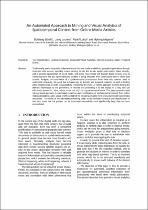 ResearchSpace
ResearchSpace
An automated approach to mining and visual analytics of spatiotemporal context from online media articles
JavaScript is disabled for your browser. Some features of this site may not work without it.
- ResearchSpace
- →
- Research Publications/Outputs
- →
- Conference Publications
- →
- View Item
| dc.contributor.author |
Sibolla, Bolelang H

|
|
| dc.contributor.author |
Lourens, Roger L

|
|
| dc.contributor.author |
Lubbe, R

|
|
| dc.contributor.author |
Magome, Mpheng D

|
|
| dc.date.accessioned | 2018-07-09T08:23:40Z | |
| dc.date.available | 2018-07-09T08:23:40Z | |
| dc.date.issued | 2018-03 | |
| dc.identifier.citation | Sibolla, B.H. et al. 2018. An automated approach to mining and visual analytics of spatiotemporal context from online media articles. Proceedings of the 4th International Conference on Geographical Information Systems Theory, Applications and Management - Volume 1: GISTAM, Funchal, Madeira, Portugal, 17-19 March 2018, pp. 211-222 | en_US |
| dc.identifier.isbn | 978-989-758-294-3 | |
| dc.identifier.uri | http://www.scitepress.org/PublicationsDetail.aspx?ID=kWpHV6FDrc4=&t=1 | |
| dc.identifier.uri | DOI: 10.5220/0006699602110222 | |
| dc.identifier.uri | http://www.scitepress.org/ProceedingsDetails.aspx?ID=bxb3QTEeduo=&t=1 | |
| dc.identifier.uri | http://hdl.handle.net/10204/10289 | |
| dc.description | Due to copyright restrictions, the attached PDF file contains the accepted version of the published item. For access to the published paper, please consult the publisher's website. | en_US |
| dc.description.abstract | Traditionally spatio-temporally referenced event data was made available to geospatial applications through structured data sources, including remote sensing, in-situ and ex-situ sensor observations. More recently, with a growing appreciation of social media, web based news media and location based services, it is an increasing trend that geo spatio-temporal context is being extracted from unstructured text or video data sources. Analysts, on observation of a spatio-temporal phenomenon from these data sources, need to understand, timeously, the event that is happening; its location and temporal existence, as well as finding other related events, in order to successfully characterise the event. A holistic approach involves finding the relevant information to the phenomena of interest and presenting it to the analyst in a way that can effectively answer the what, where, when and why of a spatio-temporal event. This paper presents a data mining based approach to automated extraction and classification of spatiotemporal context from online media publications, and a visual analytics method for providing insights from unstructured web based media documents. The results of the automated processing chain, which includes extraction and classification of text data, show that the process can be automated successfully once significantly large data has been accumulated. | en_US |
| dc.language.iso | en | en_US |
| dc.publisher | SciTePress | en_US |
| dc.relation.ispartofseries | Worklist;20790 | |
| dc.subject | Text Classification | en_US |
| dc.subject | Location Extraction | en_US |
| dc.subject | Geospatial Visual Analytics | en_US |
| dc.subject | Machine Learning | en_US |
| dc.subject | Spatio-Temporal Events | en_US |
| dc.title | An automated approach to mining and visual analytics of spatiotemporal context from online media articles | en_US |
| dc.type | Conference Presentation | en_US |
| dc.identifier.apacitation | Sibolla, B. H., Lourens, R. L., Lubbe, R., & Magome, M. D. (2018). An automated approach to mining and visual analytics of spatiotemporal context from online media articles. SciTePress. http://hdl.handle.net/10204/10289 | en_ZA |
| dc.identifier.chicagocitation | Sibolla, Bolelang H, Roger L Lourens, R Lubbe, and Mpheng D Magome. "An automated approach to mining and visual analytics of spatiotemporal context from online media articles." (2018): http://hdl.handle.net/10204/10289 | en_ZA |
| dc.identifier.vancouvercitation | Sibolla BH, Lourens RL, Lubbe R, Magome MD, An automated approach to mining and visual analytics of spatiotemporal context from online media articles; SciTePress; 2018. http://hdl.handle.net/10204/10289 . | en_ZA |
| dc.identifier.ris | TY - Conference Presentation AU - Sibolla, Bolelang H AU - Lourens, Roger L AU - Lubbe, R AU - Magome, Mpheng D AB - Traditionally spatio-temporally referenced event data was made available to geospatial applications through structured data sources, including remote sensing, in-situ and ex-situ sensor observations. More recently, with a growing appreciation of social media, web based news media and location based services, it is an increasing trend that geo spatio-temporal context is being extracted from unstructured text or video data sources. Analysts, on observation of a spatio-temporal phenomenon from these data sources, need to understand, timeously, the event that is happening; its location and temporal existence, as well as finding other related events, in order to successfully characterise the event. A holistic approach involves finding the relevant information to the phenomena of interest and presenting it to the analyst in a way that can effectively answer the what, where, when and why of a spatio-temporal event. This paper presents a data mining based approach to automated extraction and classification of spatiotemporal context from online media publications, and a visual analytics method for providing insights from unstructured web based media documents. The results of the automated processing chain, which includes extraction and classification of text data, show that the process can be automated successfully once significantly large data has been accumulated. DA - 2018-03 DB - ResearchSpace DP - CSIR KW - Text Classification KW - Location Extraction KW - Geospatial Visual Analytics KW - Machine Learning KW - Spatio-Temporal Events LK - https://researchspace.csir.co.za PY - 2018 SM - 978-989-758-294-3 T1 - An automated approach to mining and visual analytics of spatiotemporal context from online media articles TI - An automated approach to mining and visual analytics of spatiotemporal context from online media articles UR - http://hdl.handle.net/10204/10289 ER - | en_ZA |





